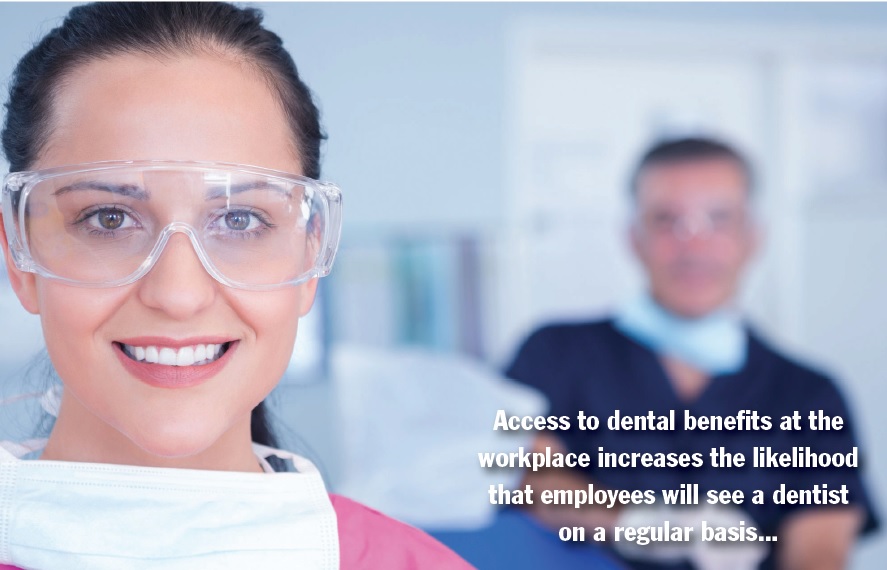BY DR. RANDI S. TILLMAN
Since the beginning of the pandemic, many of what we consider normal aspects of everyday life have been put on hold — including dental checkups. For months dental offices were closed, or available only for dental emergencies. Now many dental offices have reopened, with new infection control measures in place to help protect patients and employees.
According to Guardian Life’s latest Workplace Benefits Study, “Dental Benefits 2020,” some adults who were unable to access regular preventive care stepped up their efforts to improve their own oral health at home. On average, 20% of those surveyed reported making changes to their oral health habits, mostly for the better. Many reported practicing increased flossing, brushing more frequently and thoroughly as well as eating a healthier diet.
Given restricted access to preventive care during early 2020, many patients reported feeling ready to schedule exams this Fall, which is in line with what we are seeing nationally across dental offices. According to the American Dental Association Health Policy Institute Poll, the economic recovery of dental offices appears to be leveling off nationally with 99% of dental offices open and patient volume at 74% of pre-COVID-19 levels. (HPI Poll: Economic Recovery from COVID-19 Pandemic Leveling Off Nationally, September 8, 2020).
Given the current public health issue, our findings showed that respondents all expressed the need for increased safety precautions to reduce their anxiety around in-person visits, along with enhanced communication with their dental office.
Patients planning to visit their dentist ranked using protective equipment and physical distancing or limiting the number of patients in the office as their top concerns. Since the onset of COVID-19, this has been a top priority for the dental profession, which has always been strongly committed to infection control protocols and has now implemented practices that are in strict compliance with CDC guidelines. The good news is that a majority of adults (52%) claimed that their level of anxiety about visiting the dentist did not change due to the pandemic.
In addition to gauging overall consumer sentiment around oral health during the pandemic, there are several key takeaways from our findings that brokers should take note of:
DENTAL BENEFITS POSITIVELY INFLUENCE PREVENTIVE CARE
The American Dental Association (ADA) currently recommends dental visits at least once every six months to maintain oral health and to help detect issues early. While eight in 10 adults believe oral health is important, many do not receive regular preventive dental care. Even before the pandemic began, less than half (45%) received semiannual exams.
Our study found that in 2019, 73% of U.S. adults visited the dentist for preventive care, down slightly from 77% in 2017. Just over 40% saw the dentist for basic or major restorative services last year.
We also continue to find that oral preventive care is largely tied to whether Americans have dental benefits. For example, our study confirmed that most Americans get their dental benefits through their employer (58%). Regardless of age or income, adults with dental benefits are twice as likely to visit the dentist two times a year for preventive care than those without any benefits (30%). This reinforces what many of us know — access to dental benefits at the workplace increases the likelihood that employees will see a dentist on a regular basis, leading to better oral health.
ORAL HEALTH EDUCATION CONTINUES TO MATTER
The idea that oral health is connected to our overall health has become more widely discussed and accepted, particularly as Americans become more active in taking control of their health and wellness. For example, nearly eight in 10 respondents rated oral health highly important, with little change since the pandemic.
And while some adults recognize that proper oral care and regular dental visits can help prevent gum disease and tooth decay as well as help mitigate the need for more extensive dental work, many do not know how often they should visit the dentist or how often to brush and floss. Additionally, some adults admit to placing lower priority on oral health, including those who are younger, have lower income, see the dentist less often, and self-report “poor” oral health.
This continues to underscore the importance of educating consumers about oral health — and the workplace is one place to start. With health and wellness growing as a company- wide initiative, employers have an opportunity to play a role by integrating oral care education into their overall health and wellness campaigns.
Sometimes a simple reminder like “have you seen your dentist this year?” during enrollment season or reminding employees they have until the end of the year to get their visits in can help.

TELEDENTISTRY IS HERE
Teledentistry, digital communication and online self-service tools are now significantly more accessible from dentists due to the pandemic. Many providers can consult with patients using electronic means like video conferencing to monitor patient oral health and discuss specific concerns.
While most respondents were unaware if their provider even offered teledentistry services or whether teledentistry was covered by their dental insurance, more than one-third said they would be open to trying teledentistry. Some said they favored it over traditional in-person visits for certain conditions and situations — such as when physically unable to go in person due to caring for young children or an elderly parent, or because of work schedules.
Our findings revealed that 1 in 6 adults reported feeling more positive about teledentistry since the pandemic, and nearly 1 in 4 were open to using teledentistry, even after dentists started seeing patients again. Regarding the level of interest in teledentistry, millennials and working parents were the most likely to use teledentistry in the future. In fact, parents were more likely to use teledentistry for their child than themselves, both during and after the pandemic.
WHAT CAN BROKERS DO TO PROMOTE DENTAL BENEFITS
Dental benefits continue to be valuable for employees and perceived as an important health benefit, second to medical insurance. As more employees recognize that oral care is important to overall health, there is likely to be a growing expectation that employers provide dental benefits as part of their overall employee benefits package. This makes it important that brokers continue to work with carriers to communicate the benefits of dental insurance, while at the same time, advocating for the promotion of good oral health.
Additionally, consumer expecta- tions continue to evolve. One thing we’ve learned during this pandemic is that telemedicine is likely here to stay. Brokers should probably look at carriers who can provide flexible plan designs and include features that matter to consumers, such as teledentistry. Finally, we understand that cost-savings is top of mind for many employers these days. As brokers work with their clients to save costs, dental benefits are still one of the most affordable benefits in the marketplace, and as our findings show, it’s one benefit that helps contribute to one’s overall health.
 RANDI S. TILLMAN, DMD, MBA, is a seasoned healthcare professional with more than 30 years of experience in dental insurance, managed care, and health economics. In 2017, she joined Guardian Life as chief dental officer where she is responsible for clinical policy, claims adjudication, oral health and wellness initiatives and clinical professional training. Dr. Tillman earned her DMD from the University of Pennsylvania School of Dental Medicine and an MBA from Columbia University.
RANDI S. TILLMAN, DMD, MBA, is a seasoned healthcare professional with more than 30 years of experience in dental insurance, managed care, and health economics. In 2017, she joined Guardian Life as chief dental officer where she is responsible for clinical policy, claims adjudication, oral health and wellness initiatives and clinical professional training. Dr. Tillman earned her DMD from the University of Pennsylvania School of Dental Medicine and an MBA from Columbia University.
